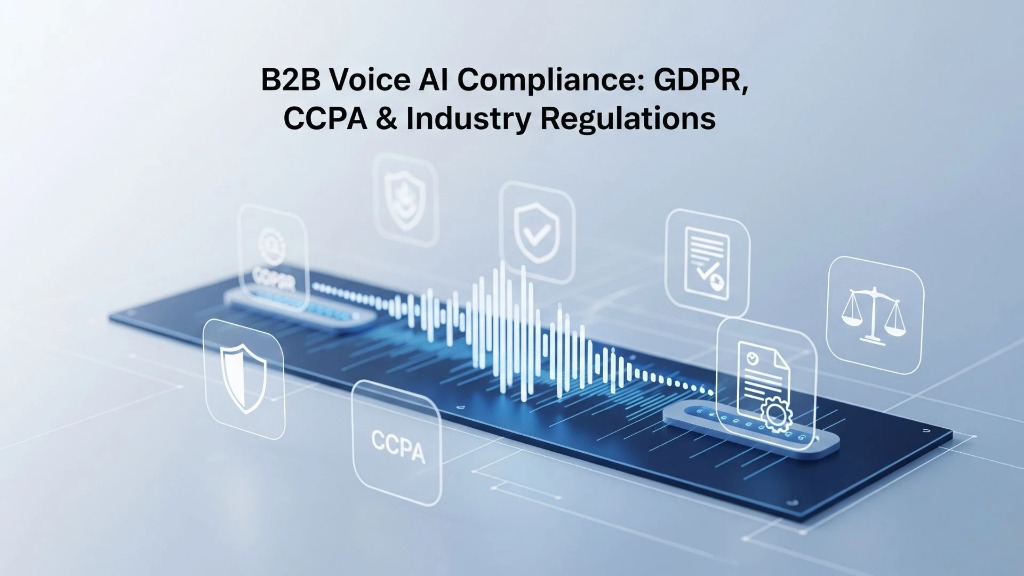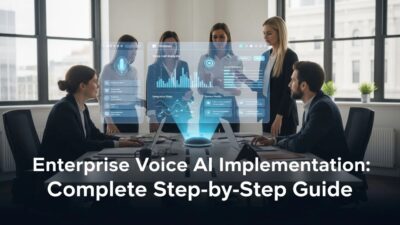B2B voice AI compliance has become a critical concern for businesses implementing conversational AI systems. Companies must navigate complex regulatory frameworks to protect customer data. Voice AI systems process sensitive personal information daily. Compliance failures can result in massive fines and reputation damage.
Table of Contents
Understanding B2B Voice AI Compliance Requirements
Voice AI platforms collect extensive user data during conversations. This data includes voice patterns, speech content, and behavioral insights. Regulatory bodies classify voice data as biometric information. Personal identifiers fall under strict data protection laws.
GDPR (General Data Protection Regulation) applies to any EU citizen’s voice data processing. CCPA governs California residents’ voice information handling. Other jurisdictions have similar data protection requirements. Companies must implement comprehensive compliance strategies.
Key Regulatory Frameworks Affecting Voice AI
AI GDPR compliance European regulations impose strict voice data handling requirements. Organizations must obtain explicit consent before processing voice information. Data subjects have rights to access, modify, and delete their voice data. Non-compliance can result in fines up to 4% of global revenue.
CCPA (California Consumer Privacy Act) California law grants consumers control over their voice data. Businesses must disclose voice data collection practices clearly. Consumers can request deletion of their voice recordings. Companies must implement opt-out mechanisms for data sales.
HIPAA (Health Insurance Portability and Accountability Act) Healthcare organizations using voice AI face additional requirements. Patient voice data requires enhanced security measures. Business associate agreements must cover voice AI vendors. Breach notifications have strict timelines.
AI GDPR Compliance Best Practices for Voice Technology
Data Collection and Consent Management
Voice AI systems must implement granular consent mechanisms. Users should understand exactly what voice data gets collected. Consent forms need clear, non-technical language. Companies must provide easy consent withdrawal options.
Recording notifications must be prominent and clear. Users should know when voice processing begins and ends. Consent should be separate from other service agreements. Regular consent renewals may be required.
Data Processing Limitations
Voice AI processing should follow data minimization principles. Systems should only collect necessary voice information. Processing purposes must be clearly defined and limited. Companies cannot use voice data for unrelated purposes.
Automated decision-making using voice data requires special protections. Users must be informed about AI-driven decisions. Appeals processes should be available for contested decisions. Human oversight remains essential for critical determinations.
Cross-Border Data Transfer Compliance
International voice data transfers require careful legal analysis. Standard contractual clauses may be necessary. Some jurisdictions prohibit certain voice data exports. Companies must map their global data flows comprehensively.
Cloud storage locations affect compliance requirements significantly. Voice AI vendors must provide clear data residency options. Encryption standards vary by jurisdiction. Regular compliance audits become essential.
Industry-Specific Voice AI Compliance Considerations
Financial Services Regulations
Banks using voice AI face multiple compliance layers. PCI DSS requirements apply to payment-related voice interactions. Anti-money laundering rules affect voice authentication systems. Financial privacy laws impose additional restrictions.
Voice banking systems must implement strong authentication measures. Transaction confirmations through voice AI require special protocols. Customer identification procedures must remain robust. Regular security assessments are mandatory.
Healthcare Voice AI Compliance
Medical voice AI systems must protect patient information rigorously. HIPAA compliance requires comprehensive security measures. Voice recordings containing health information need special handling. Healthcare providers must train staff on voice AI privacy.
Patient consent for voice AI must be documented thoroughly. Medical voice data retention periods are strictly regulated. Breach notification requirements are particularly stringent. Regular risk assessments help maintain compliance.
Education Sector Requirements
Educational institutions using voice AI face unique challenges. FERPA protects student voice data in educational settings. Parental consent may be required for minor students. Age verification becomes crucial for compliance.
Student voice data cannot be used for commercial purposes. Educational records containing voice information require special protection. Data retention policies must align with educational regulations. Regular staff training ensures ongoing compliance.
Technical Implementation for Voice AI Compliance
Privacy by Design Architecture
Voice AI systems should embed privacy from the ground up. Data protection measures must be proactive rather than reactive. Privacy settings should default to the most protective options. Technical safeguards must be continuously updated.
System architecture should minimize data collection automatically. Voice processing should occur locally when possible. Cloud processing requires enhanced security measures. Regular security audits help identify vulnerabilities.
Encryption and Security Standards
Voice data encryption must meet industry standards. End-to-end encryption protects voice communications throughout transmission. Storage encryption prevents unauthorized access to voice recordings. Key management systems require robust security protocols.
Access controls must be granular and regularly reviewed. Voice data should be accessible only to authorized personnel. Audit trails must track all voice data access. Regular access reviews help maintain security.
Data Retention and Deletion Policies
Voice AI systems must implement automated deletion schedules. Retention periods should align with legal requirements. Users must be able to request immediate deletion. Deletion processes should be verifiable and complete.
Backup systems must also comply with retention policies. Voice data in development environments needs careful management. Regular purging processes help maintain compliance. Documentation of deletion activities is essential.
Building a Comprehensive Voice AI Compliance Program
Risk Assessment and Management
Organizations must conduct regular voice AI risk assessments. These assessments should identify potential compliance vulnerabilities. Risk mitigation strategies must be documented and implemented. Regular updates ensure assessments remain current.
Compliance risks vary by industry and jurisdiction. Voice AI vendors should provide compliance documentation. Internal compliance teams need voice AI expertise. External legal counsel may be necessary for complex situations.
Staff Training and Awareness
Employees handling voice AI systems need specialized training. Privacy principles must be understood by all relevant staff. Regular training updates keep knowledge current. Compliance violations should have clear consequences.
Training programs should cover technical and legal aspects. Role-specific training addresses different compliance responsibilities. Regular assessments ensure training effectiveness. Documentation proves training completion.
Vendor Management and Due Diligence
Voice AI vendors must demonstrate compliance capabilities. Due diligence processes should evaluate vendor security measures. Contracts must include comprehensive compliance requirements. Regular vendor audits help ensure ongoing compliance.
Vendor selection criteria should prioritize compliance features. Data processing agreements must be carefully negotiated. Vendor security certifications should be verified regularly. Incident response procedures must be coordinated.
Monitoring and Maintaining Voice AI Compliance
Continuous Monitoring Systems
Automated monitoring helps detect compliance violations early. Real-time alerts notify teams of potential issues. Regular compliance reports track key metrics. Monitoring systems must be regularly updated.
Voice AI usage patterns should be analyzed for compliance risks. Unusual data access patterns may indicate security issues. Regular compliance dashboards provide visibility. Automated compliance checks reduce manual effort.
Incident Response Planning
Voice AI compliance incidents require specialized response procedures. Incident response teams need voice AI expertise. Communication plans must address regulatory notifications. Recovery procedures should minimize ongoing compliance risks.
Incident documentation must be thorough and accurate. Regulatory notifications have strict timelines. Post-incident reviews help prevent future violations. Incident response plans require regular testing.
Regular Compliance Audits
Internal audits help identify compliance gaps before regulators do. Audit schedules should align with regulatory requirements. External audits provide independent compliance validation. Audit findings must be addressed promptly.
Audit documentation must be maintained according to regulations. Corrective action plans need clear timelines. Regular follow-up ensures audit recommendations are implemented. Compliance metrics help track improvement over time.
Future Trends in Voice AI Compliance
Evolving Regulatory Landscape
New regulations continue to emerge globally. Existing laws are being updated to address AI specifically. Enforcement actions are becoming more frequent and severe. Companies must stay informed about regulatory changes.
International cooperation on AI regulation is increasing. Harmonized standards may emerge over time. Compliance requirements will likely become more stringent. Early adoption of best practices provides competitive advantages.
Read More: Political Campaign Voice Bots: Election Law Compliance
Emerging Technologies and Compliance

Voice AI technology continues to evolve rapidly. New capabilities create new compliance challenges. Emerging technologies like deepfakes raise additional concerns. Compliance frameworks must adapt to technological changes.
Edge computing for voice AI affects compliance strategies. Quantum computing may impact encryption requirements. Artificial general intelligence will require new regulatory approaches. Compliance teams must prepare for technological disruption.
Voice AI compliance represents both a challenge and an opportunity for businesses. Organizations that invest in robust compliance programs build customer trust. Compliance excellence can become a competitive differentiator. The investment in compliance pays dividends through reduced regulatory risk.
Success requires ongoing commitment and resources. Compliance is not a one-time project but an ongoing process. Regular updates and improvements ensure continued effectiveness. Organizations that prioritize compliance will thrive in the evolving regulatory environment.
Building a comprehensive voice AI compliance program takes time and expertise. The complexity of regulations requires specialized knowledge. However, the benefits of compliance far outweigh the costs. Companies that embrace compliance requirements position themselves for long-term success in the voice AI marketplace.






[…] TCPA AI calling violations happen when businesses call without permission. Many companies don’t understand the complex consent requirements. Simple mistakes lead to expensive lawsuits. […]